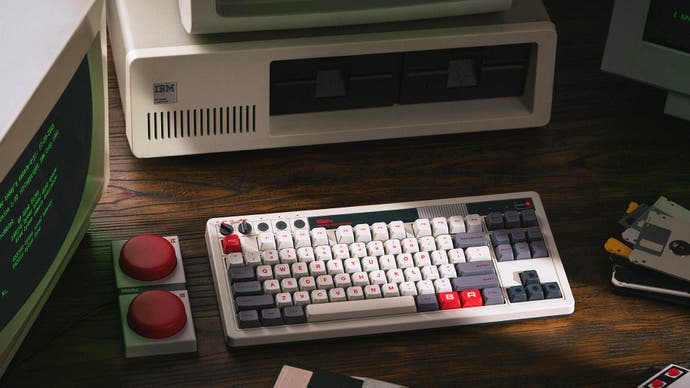Best mechanical keyboard 2024: 14 picks for gaming, typing and coding
Digital Foundry's expert recommendations for quiet, compact and full-fat gaming keyboards.
Mechanical keyboards are now a mainstay of the gaming and programming communities, offering more customisability, better performance, improved longevity and just a better typing experience than your standard rubber dome keyboard. We've come a long way since these keyboards first hit the mainstream in 2010, and now there are thousands of different models available from brands big and small. But which is the best option for you?
To answer this question, we've tested more than 150 keyboards since 2018, from the cheapest entry-level options to some of most fully-featured flagship models specialised for gaming, coding and more. Let's take a look at the 14 best mechanical keyboards on the market, all tried and tested by Digital Foundry.
Note: The pictures of each keyboard show either a UK or US layout, but I've linked to the appropriate regional layout wherever possible - so don't worry if you see a keyboard with a different-sized Enter key than what you're used to!
Click the links below to jump right into the category you're most interested in. We've chosen keyboards for programming, gaming, building yourself and much more, so take a look. If you're not sure, scroll on to browse our full selection of recommendations!
Best mechanical keyboard 2024
- Best full-size mechanical keyboard: Corsair K70 Max
- Best TKL mechanical keyboard: Nuphy Gem80
- Best 65 percent mechanical keyboard: Fnatic Streak 65
- Best mechanical keyboard for laptops: Nuphy Air75 V2
- Best 60 percent mechanical keyboard: Razer Huntsman Mini
- Best wireless keyboard: Logitech G915 TKL
- Best quiet mechanical keyboard: Epomaker Shadow-X
- Best mechanical keyboard for coding or typing: Drop CTRL V2
- Best cheap mechanical keyboard: Redragon K673 Pro
- Best compact keyboard: Keychron K2
- Best mechanical keyboard for Mac: Das Keyboard MacTigr
- Best retro mechanical keyboard: 8BitDo Retro Mechanical Keyboard
- Best rapid trigger keyboard : Wooting 60HE
- Best modular keyboard: Mountain Everest Max
Best full-size mechanical keyboard: Corsair K70 Max

When it comes to gaming-focused mechanical keyboards, few can match Corsair's high-end models for pure depth of features. The £210/$175 Corsair K70 Max is the company's best flagship-grade option, with Hall Effect switches*, an 8000Hz polling rate and added layers of sound-dampening foam. This, combined with the high-quality PBT keycaps, produces a very comfortable typing experience that's a noticeable step up from earlier (and admittedly much cheaper) Corsair K70 models.
*Hall effect switches essentially use a magnet to detect precisely how far down a key has been pressed, allowing you to do things like have a rapid trigger for faster inputs, have a half-press and a full-press trigger different actions, or set up the keyboard to respond right at the very top of a key press for fast-paced games or right at the very bottom to avoid typos. These type of switches were brought to gaming keyboards initially by Wooting and have since adopted by Razer and SteelSeries, amongst others.
The K70 may not be the best choice for FPS gaming, as its full-size layout (complete with volume roller, media keys and tournament mode toggle) doesn't leave much space alongside for low-DPI mice to be flicked around. I dig the low profile metal chassis though, which is newly inscribed with a hexagonal motif seen on other recent Corsair releases - though boutique keyboard makers offer more visually interesting designs, it has to be said.
Overall, the K70 Max is a reliable choice that ticks all the boxes in terms of gaming features while improving the typing experience over its predecessors. This is a strong option in the here-and-now, and will become even better value when Corsair's typically aggressive pricing strategy brings it to a ~£150 price point.
We have more full-size options in our dedicated best full-size mechanical keyboards article too!
Best TKL mechanical keyboard: Nuphy Gem80

The best TKL (tenkeyless, no numpad) keyboard we've tested in 14 years is a phenomenal custom keyboard you build yourself, the Nuphy Gem80. This board is built from a thick slab of polished aluminium (in black, mocha, blue, pink or purple) and costs a fair bit as a result: £124/$165 shipped (with code DF10), plus $15 extra each for switches and keycaps if you're not providing your own. In exchange though, you get an all-star performer that feels incredible for typing, coding and gaming.
Beneath the gleaming aluminium chassis, there are plenty of clever design choices: six kinds of sound dampening to produce a beautifully deep report with every keypress, hot-swappable sockets that support three mounting styles (top, bottom, gasket), a polycarbonate bottom for the wireless model's 2.4GHz and Bluetooth, dedicated Mac/Windows and wireless/wired switches, QMK/VIA programmable firmware, RGB backlighting, and upgraded circuitry for lower latency wired and wireless connections. It's a technical tour-de-force, and the only you're really lacking here is gaming-focused rapid trigger technology from Hall Effect switches or 2000Hz+ polling rates - neither of which is necessary outside of a competitive context.
My blue-coloured ('mystic indigo') review unit came with a silver/green detachable USB-C cable and 37g 'Mint' linear switches produced by Gateron, which provided a smooth and rapid keypress with a nice sound profile ('Raspberry' 46g linear and 'Lemon' 55g tactile options plus Cherry-made 'Silent Red Clear-Top' 45g linear switches are also available). Of course, you're also free to drop in your own 3-pin or 5-pin MX-style switches. One thing you can't pick up is an ISO (EU/UK) layout - this board is ANSI (US) only, complete with a short enter key and long left shift. That's annoying for folks only used to European layouts, but does at least widen your custom keycap options considerably.

The mSA profile double-shot PBT keycaps provided with my unit are also exceptional, with a more rounded shape than most other styles on the market and interesting backlit homing bars, which provide both visual and tactile markers for where your fingers should rest for home row typing. These feel great to use, with just enough texture for typing and gaming, while also looking exceptional - it's clear that Nuphy takes its aesthetics very seriously, with nicely chosen iconography and clean, centred and all-caps legends. Installing the switches and keycaps is the work of a half-hour or less and can be accomplished by a complete novice, so don't be put off by the self-asasembly!
Typing or gaming on the Gem80 just makes me happy, and that's why it is ranked so highly amongst our recommendations. I think Nuphy have cracked the perfect mixture between the accessibility of a mass-market design and the genuine quality of a custom board, for a result that is incredibly easy to recommend.
Best 65 percent mechanical keyboard: Fnatic Streak 65

The £115/$110 Fnatic Streak 65 is our favourite compact keyboard, offering all of the functionality you need for competitive games in a small, convenient form factor that gives you plenty of space for your mouse and superior ergonomics. The keyboard uses Fnatic's own silent, linear and low profile 'speed' mechanical switches, allowing extremely rapid key presses and making double-taps easier. The layout is slightly wider than the 60 percent size Razer Huntsman Mini below, but adds dedicated arrow keys and four programmable keys - I think most people will benefit from these inclusions. As well as not taking up much desk space, a 22mm height and 420g weight means that this keyboard will fit in a bag or even the front pocket of a hoodie easily. The compact dimensions and aluminium frame contribute to a very sturdy feel too.
Beyond the form factor, Fnatic have done well to nail the details here as well. The stabilisers on larger keys are pre-lubed for silent and easy operation, the USB-C port is offset to the left to ensure the cable doesn't interfere with your mouse and the legends on each keycap are inscribed with a legible font that feels more grown-up than those on most gaming keyboards. The switch housings are even transparent and two extra LEDs are embedded beneath the space bar to ensure that the customisable RGB lighting is evenly distributed throughout the board. I particularly liked the inclusion of a 'competition mode', which sets to the lighting to dim orange and locks the Windows key.
Altogether, this tiny Streak is every bit as easy to love as its bigger brothers and certainly among the best gaming keyboards on the market.
See our best 65 percent keyboard picks for more recommendations in this form factor.
Best mechanical keyboard for laptops: Nuphy Air75 V2
_q6pEfST.jpg?width=690&quality=75&format=jpg&auto=webp)
The best mechanical keyboard for laptops we've tested is the Nuphy Air75 V2 which costs £101/$123 shipped (with code DF10). This is a gorgeous keyboard with a ton of clever design innovations, from slim and spherical PBT keycaps in a pleasant colour scheme, 'AirFeet' that allow the keyboard to be placed directly on top of MacBooks and many Windows laptops, and even RGB light bars on either side that indicate the current mode and battery life.
The Air75 V2 provides a welcome upgrade when it comes to the typing experience too, providing bags more tactile feedback, key travel and comfort. You can even pick up a beautiful $19 folio case which folds around the 16mm keyboard to protect it during travel and props up smartphones and tablets.
You have the option of USB-C, 2.4GHz wireless and Bluetooth 5.0 connectivity, while both Mac and Windows systems are supported with keycaps for both in the box. The low profile switches are hot-swappable too, so you can use a wide range of replacements with different characteristics. I tested a model with low profile Gateron Brown 2.0 switches, and found they offered a good blend of tactility and smooth, silent operation. Given its flexibility, typing experience, build quality and aesthetics, the Air75 V2 is a superlative option for its price.
Best 60 percent mechanical keyboard: Razer Huntsman Mini
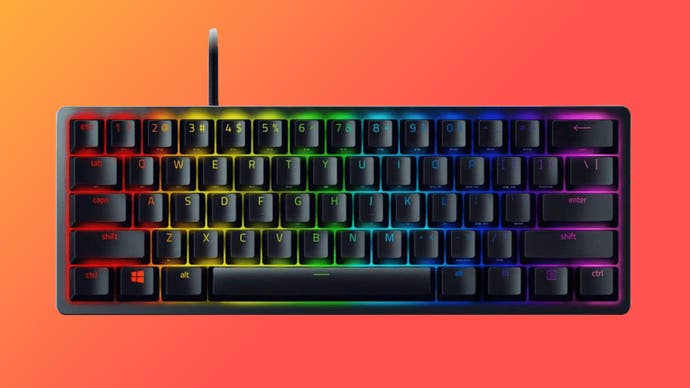
The 60 percent size is a favourite of mechanical keyboard enthusiasts, but one that saw remarkably little attention from major gaming brands before 2020. Our current favourite is the £105/$67 Razer Huntsman Mini.
Like other 60 percent boards, there's no f-key row, no num-pad, no nav cluster and no arrow keys. That results in a beautifully clean keyboard that takes up minimal desk space, while still allowing access to the excised functions via a Function layer. As 60 percent is an aesthetic as much as a practical choice, it's nice to see Razer offer both black and white colour options for the keyboard's chassis and keycaps - and a completely standard layout that allows for custom keycap sets to be installed. Similarly, it's great to see a removable USB-C cable, allowing fans to install custom-made cables to further customise their board.
Of course, the Huntsman Mini doesn't get a spot on our list just for looking nice. It also feels great to use, with Razer's individually-stabilised optical switches delivering consistent feedback with minimal key wobble. We tested a unit with soft linear red switches with a 1mm actuation distance and 40g actuation force, but clicky purple switches with a 1.5mm actuation distance and 45g actuation force are also offered. The keycaps themselves are also unusually high quality, made from PBT with shine-through legends, so they feel great and won't succumb to the shiny patches that can afflict lower-quality ABS keycaps.
As well as these unique switches, the Huntsman Mini also sets itself apart with its Synapse software, which allows you to set intricate custom lighting modes - something impossible on keyboards that can only switch between a few preset effects. You can also synchronise your lighting with other RGB-encrusted Razer peripherals or supported Razer Chroma games, which is a nice bonus.
See our best 60 percent keyboard picks for more compact keyboard ideas.
Best wireless keyboard: Logitech G915 TKL

The £155/$120 Logitech G915 TKL is the fusion of two growing trends from the very companies that promulgated them: dependable, low-latency wireless connectivity from Logitech and low-profile, laptop-like mechanical switches from Kailh. The combination is an impressive one, allowing the construction of an ultra-thin keyboard for gaming and typing that feels great to use and looks super clean on your desk - especially in this new compact form factor. There are three low profile switch types offered here right off the bat - clicky, tactile and linear - so you can opt for the amount of tactile and audible feedback that makes sense to you.
The Lightspeed wireless connection worked perfectly in our testing, providing the same wired feel as Logitech's G Pro Wireless gaming mouse. Battery life was also strong, at around 40 hours with backlighting at max brightness - ten more hours than the full-size G915. (If you turn down the backlight, the G915 TKL manages over a thousand hours!) Bluetooth is also available, which adds more latency but allows the keyboard to work with devices like phones and tablets; it's possible to switch between Bluetooth and Lightspeed connections with a press of a button which makes it a convenient companion for a smartphone, iPad or laptop without a full-size USB port.
Elsewhere, Logitech has paid an impressive amount of attention to detail. The aluminium alloy body of the G915 TKL feels incredibly robust despite its thin design, with softly rounded corners and a comfortable "zero friction" volume roller in the upper right corner. The tenkeyless design means that there's no dedicated macro keys or number pad, as we saw on the full-size G915, but there are still media controls beneath the volume roller and various profile settings along the top. RGB backlighting is included beneath each key, which of course can be set to a single colour, turned down or disabled entirely if you prefer.
Best quiet mechanical keyboard: Epomaker Shadow-X
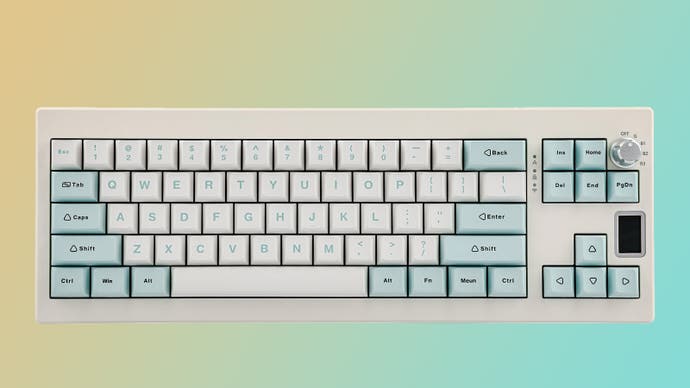
The £73/$69 Epomaker Shadow-X is a quiet mechanical keyboard with a unique 70 percent layout and extras including an integrated display, a metal mode select knob and tri-mode wireless and wired connectivity. It's also available with some interesting switches, which run the full gamut from linear to clicky.
The soft key feel and quiet (but not silent) typing sound is down to the keyboard's gasket-mounted switches and Poron sound absorbing foam, which cuts down on the noise that normally accompanies typing on a mechanical keyboard. I'm a big fan of how this keyboard looks too, with a chunky keycap lettering, a choice of several interesting colourways and a weighty aluminium chassis. The placement of the screen in between the arrow keys and the navigation cluster is one area for improvement, as it makes the keyboard a little lop-sided and perhaps would have been better placed horizontally alongside the knob in place of the nav keys.
The feature list is strong too as we noted above, with a pleasantly clunky knob for switching between wired, Bluetooth and 2.4GHz wireless modes, hot-swappable switches and accompanying software for PC and Mac. The Shadow-X has been great fun to use and sounds great, thanks to those internal modifications and the thick PBT keycaps it comes equipped with.
If you can get on with the relatively unique 70 percent layout that leaves out Function keys but does include a standard assortment of arrow and navigation keys minus Page Up, then this innovative indie keyboard is well worth a look.
Best mechanical keyboard for coding or typing: Drop CTRL V2
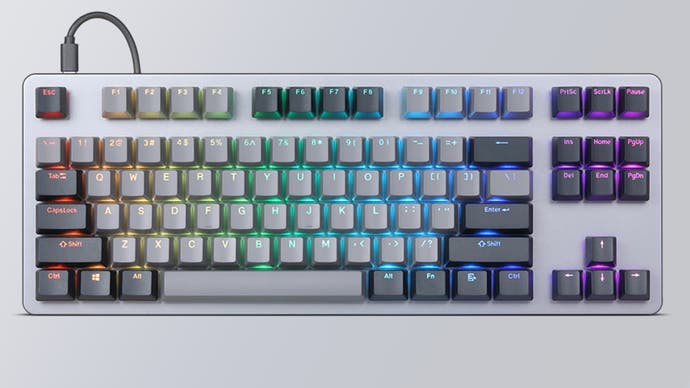
The $169 Drop CTRL V2 is the best-built and most cleanly designed mechanical keyboard for gaming we've tested. Available in a compact yet convenient TKL (tenkeyless, aka 'no numpad') layout, the CTRL has a minimal footprint, with no extra keys for macros, media controls and the like; these functions are handled by a Fn layer. The keyboard comes in black or grey with Gateron Yellow or Holy Panda X Clear switches. The 3/5-pin switch mounts are hot-swappable, so you can fit any other standard MX-style switches in if you prefer.
The aluminium used on the top and bottom makes the keyboard extremely resistant to deck flex; it feels as well-built as an old IBM Model M but in a much more compact form factor. USB-C is also included, with a non-recessed port that means that pretty much any USB-C data cable can be used. The black and grey PBT keycaps provided with the board look great, and the entirely standard layout means that you can swap them for a set of custom keycaps in the colour or material of your choice without difficulty.
Compared to the earlier Ctrl V1, the V2 model has better 'Phantom' stabilisers, foam inserts for a deeper sound and a more powerful chipset. An RGB wave lighting effect is enabled by default, but there are several calmer presets available - and more of them than with V1 - and you can use Drop's configurator to make your own custom key layouts and lighting settings. This is a powerful option for advanced users, but perhaps lacks the accessibility of software from more prominent keyboard brands.
All things considered, the CTRL V2 is a fantastic keyboard for gaming or programming with a nice clean aesthetic.
Best cheap mechanical keyboard: Redragon K673 Pro
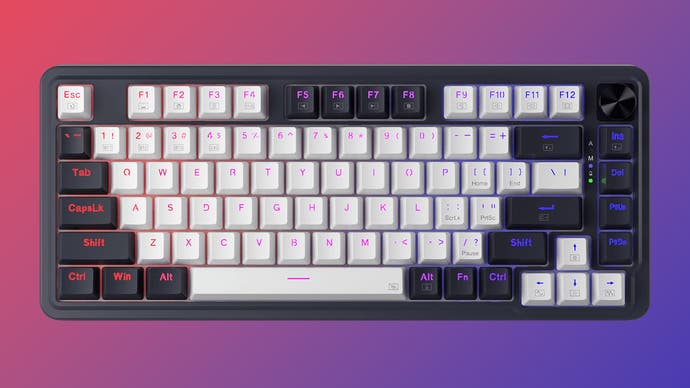
The Redragon K673 Pro, at £58/$65, is the cheapest keyboard I've seen that still includes basically all of the 2024 trends*: gasket-mounted hot-swappable mechanical switches, noise-dampening foam, a volume knob, tri-mode connectivity, RGB lighting and an interesting colour scheme.
The linear red switches here perhaps lack a bit of the character of more interesting tactile or clicky models, but this is still a proper modern mechanical keyboard with all of the key feel, customisation and durability advantages that provides. The 81-key layout is well arranged and ensures you still have accessed to the arrow and most navigation keys, often used for text editing, while taking up less space than larger TKL or full-size layouts. The volume wheel in the upper right is nicely tactile for easy one-handed use, and a Function layer allows access to media, lighting and other extra controls.
For the money, this is an exceptional value mechanical keyboard that only pales against significantly more expensive opposition - in its $55/£60 price class, I'd challenge you to find anything better.
*The only thing you're really missing here is an 8000Hz polling rate and rapid trigger support - but don't worry, Redragon have a £57/$72 w/ code DIGITALFOUNDRY K617 Fizz keyboard for that too, though it lacks some features of the K673 Pro.
Best compact keyboard: Keychron K2
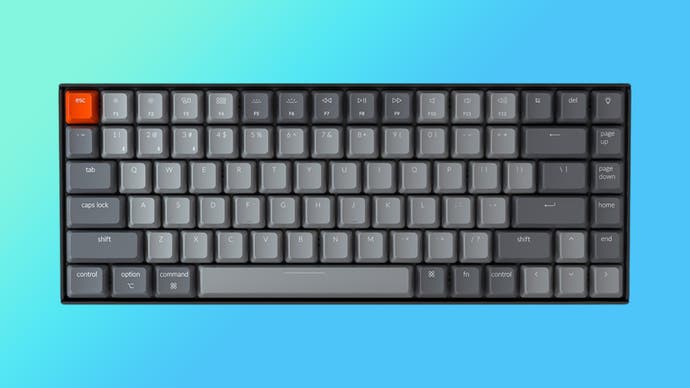
The best compact keyboard I've tested is the £89/$72 Keychron K2. Originally on Kickstarter, this 84-key mechanical keyboard comes with a choice with Brown, Blue or Red switches and - unusually - both macOS and Windows keycaps in the box. This keyboard has an 80 percent layout, so it misses out the numpad but still has arrow keys on the bottom right, F keys at the top of the keyboard and a single column of navigational keys on the right side. That provides considerable space savings compared to a standard or tenkeyless design, while still keeping the most important keys within easy reach. As you'd hope for such a portable keyboard, the K2 supports both Bluetooth and USB-C connections, so it can be used in both wired and wireless modes with a range of devices.
The Keychron K2 performed excellently in my testing, with a satisfying feel from the Brown Gateron switches, while the aluminium frame looks great and ensures this keyboard can survive quite a bit. This model also comes with full RGB backlighting, including a number of different effects. Given this keyboard's long feature list and great build quality, it's a surprise to find that it's also among the most affordable keyboards in its category. The deluxe model with an aluminium frame and RGB costs $89 plus shipping. Swap the metal frame for plastic to save $10, and chop another tenner off the price by opting for white backlighting instead of RGB.
Best mechanical keyboard for Mac: Das Keyboard MacTigr
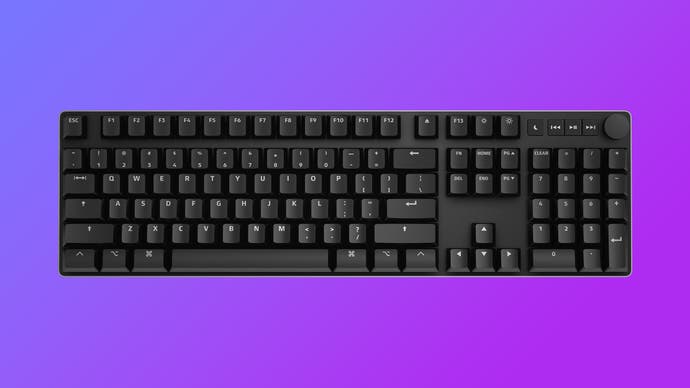
The Das Keyboard MacTigr is an excellent choice for Macs, with a brilliant typing experience, plenty of nice touches and tank-like build quality at an ultra-premium $189/£199. Das has put every effort in to make the MacTigr both functional and lovely to use, with a twiddly volume wheel with tactile-feeling multimedia playback buttons, a full Mac function row and a pair of USB-C passthrough ports on the back of the board.
Keeping in with that pleasant user experience theme, it's also a keyboard that offers a smooth and light keypress with Cherry MX Low Profile Red switches. The MacTigr also comes with full n-key rollover so you can push down as many keys as you want, which is critical for some game genres and otherwise ensures no key presses go unregistered. The keyboard is also supremely built and should last for decades, which is nice.
As for bugbears, the lack of any form of key illumination, RGB or not, is a bit of a pain, as is the lack of any software-based configuration to unlock the MacTigr's true potential. And of course, there's the premium asking price, which is substantial. Therefore, for more Mac-friendly mechanical keyboards, check out our full best keyboards for Mac article.
Best retro mechanical keyboard: 8BitDo Retro Mechanical Keyboard

The £96/$98 8BitDo Retro Mechanical Keyboard is a beautifully crafted modern keyboard in the retro style, offering a sensible TKL (no numpad) layout, high-quality PBT keycaps, convenient dials for volume and connectivity, and some fantastically clicky Kailh Box White V2 switches. As well as the NES-style colourway shown above, you can also pick up the keyboard in Famicon (£85/$90), C64 (£85/$110) or IBM Model M (£85/$92) inspired liveries.
8BitDo has made something quite special here, as not only do you get wired, Bluetooth and 2.4GHz wireless (the latter via an on-theme dongle tucked into the back of the keyboard), but you also get four connection points for 'super programmable buttons', which are (super-sized) dead ringers for the Nintendo Entertainment System's A and B buttons. One clicky two-button set is included in the box, and I found it quite useful for triggering macros or skipping tracks via the "8BitDo Ultimate Software V2" app. (Additional buttons, a joystick and a four-button macro pad in a d-pad arrangement are sold separately.) It's worth noting that there's no backlighting here, but otherwise you get the mechanical nice-to-haves - a hot-swap PCB, n-key rollover and nicely designed status LEDs.
What else is there to say? This is a simply lovely retro mechanical keyboard that I wholeheartedly recommend.
Best rapid trigger keyboard: Wooting 60HE
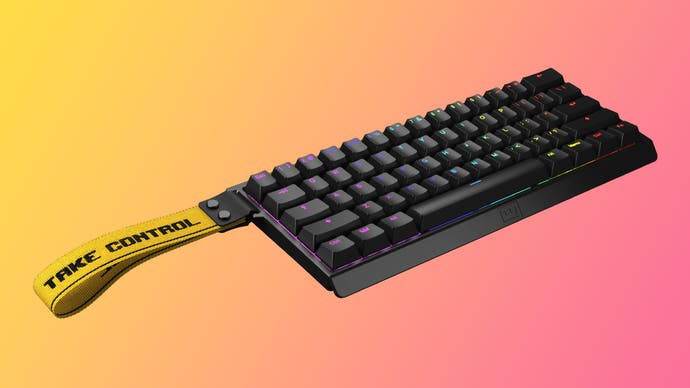
The £133/$175 Wooting 60HE is something special: a Hall Effect analogue keyboard with rapid trigger support. Rapid trigger is a must-have for competitive FPS in 2024, as it recognises when a key has stopped moving up or down and instantly sends a corresponding key press or release signal, rather than waiting for the switch to travel through a set activation or deactivation point. This makes for extremely precise and rapid inputs, perfect for peeking and stopping on a dime to shoot in Counter-Strike or Valorant.
The analogue capabilities are also an interesting prospect for gaming, as the pressure-sensitive keys here allow you to steer into corners or creep around a level with the same fine-grained control you only normally only get with a wheel or controller. You can adjust the actuation point of the keyboard in software too, anywhere from 0.1 to 4.0mm, making a trade-off between speed and control that normally demands switching to an entirely different keyboard with different mechanical switches inside. You can also trigger up to four different effects as a single key is pressed and released - eg selecting a grenade with a light touch, throwing it when you bottom out the key and swapping back to your weapon as the key is released. All of this requires some setup and tweaking, but the result is something special.
The 60HE is a solid keyboard even if you use it entirely digitally too, with a clean 'floating keys' design, programmable RGB backlighting and a comfortable full-size layout with four extra keys. The use of an advanced Hall Effect sensor also means that key presses should be registered faster than traditional switches, especially when combined with the keyboard's 'tachyon mode' that strips out nonessentials like RGB effects for a lightning-fast response.
For alternative picks with different features, typical styles and form factors - and more on the Wooting 60HE and how rapid trigger works - check out our full best rapid trigger keyboards roundup.
Best modular keyboard: Mountain Everest Max

The £180/€180 Mountain Everest Max is a modular keyboard in the strictest sense of the word, offering novel customisability and a multi-part design. The centrepiece is a TKL (tenkeyless, ie no numpad) keyboard, to which three additional components can be joined: a numpad with four Stream Deck style LCD keys, a multi-function LCD wheel and media controls piece, and a palm rest. There's flexibility in the way in which these pieces come together too - the numpad can be positioned to the right as standard or on the left, an alternative that combines easy access to numeric inputs while leaving loads of room to the right of the keyboard for your mouse. The volume wheel part can also be placed on the top left or top right, according to your preference. The smaller pieces connect via USB-C and magnets, and can be freely swapped around in just a couple of seconds. The Everest Max offers all of the components in one box, along with a handful of extra switches (all of the switches here are hot swappable, so you can install your own switch of choice) and magnetically attached discs that angle the keyboard (as an alternative to flip-out feet). You can also get the base model Everest Core, which is just the TKL keyboard, or even the Everest Core Barebones which comes without switches or keycaps at a lower price.
The Everest Max is extremely convincing as a full package, and thanks to its LCD keys and the Base Camp software it can function as a mini Stream Deck alternative for controlling scenes in OBS. I found the software package a little flaky as it's still under active development, but I didn't encounter any serious bugs and the possibilities here are powerful indeed - with comprehensive controls for lighting, key binding, macros, the LCD wheel and multiple profiles. The keyboard itself is a pleasure to use too, especially with that left-handed-style layout with the numpad on the left and the multi-function wheel in the upper right. Having quick access to volume controls as well as lighting selections, a clock, PC stats and even an APM (actions per minute) counter is entirely novel and I'd love to see this on more boards in future - it's much more powerful than the OLED screen on the likes of the SteelSeries Apex Pro, which includes some similar functions but is much clumsier to use and is mostly relegated to showing a custom graphic in my experience.
So: a very interesting keyboard and I'm curious to see how the package develops further over time! I'd love to see more add-ons available that really push the boundaries of what the mechanical keyboard is capable of - and the LCD keys built into on the numpad make this a really canny pick for streamers and content creators already.
With that, our recommendations come to an end. Of course, even if we chose 200 keyboards we'd still not scratch the surface of the many options available - so if we didn't cover your favourite keyboard, it's nothing personal. If you think we've missed a good option though, feel free to get in touch with me @wsjudd.
I hope you've found this article useful, and I look forward to the feedback. If you haven't read it before, I'd also encourage you to check out our feature on how - and why - mechanical keyboards become popular in the first place.
